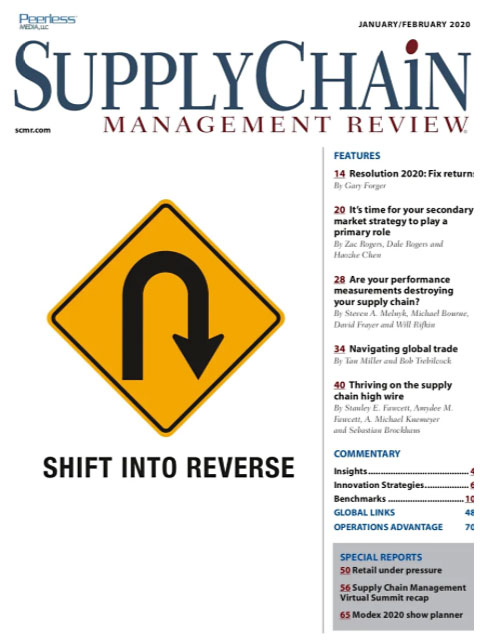Sorry, but your login has failed. Please recheck your login information and resubmit. If your subscription has expired, renew here.
January-February 2020
If the holidays at your household were like most, the gifts were chosen and wrapped with care, and then half were returned in the week after Christmas. Maybe more than half. After all, who among us hasn’t bought four shirts in a variety of sizes and colors with the intent of keeping one and returning three. And why not: Retailers and e-tailers alike have made returns seamless, easy and cheap. At least for the shopper. For the supply chains of the retailer, manufacturer or brand owner, returns are a once-neglected area that is growing into a major focus of supply chain managers who don’t want to see their organizations lose their shirt taking… Browse this issue archive.Need Help? Contact customer service 847-559-7581 More options
Over the past several decades, supply chains have truly gone global. And with that has come complexity. We’re not talking just about the challenges of synchronizing supply chains in which raw materials, parts and components produced in disparate countries need to show up just-in-time on an assembly line, or manufacturing processes that span multiple countries to produce a finished good. Rather, we’re talking about the complexity associated with trade compliance, where crossing T’s, dotting I’s and sweating the details is essential.
While trade compliance may have been a sleepy corner in most organizations in the past— sometimes residing in logistics, sometimes in procurement and sometimes in legal—that has all changed as countries like the United States renegotiate trade agreements and ramp up tariffs. For instance, the headlines on the day the authors were finishing this article announced a new trade war and renewed tariffs on steel and aluminum from Brazil and Argentina. The terms day of a new agreement with China were still being negotiated. Continued uncertainty was the theme of the day.
Last April, four experts with years of experience navigating global trade discussed the challenges and opportunities facing trade compliance professionals at a supply chain symposium at Rider University. The symposium was organized by Tan Miller, director of Rider’s global supply chain management program. They were: Bob Murray, chairman, REM Associates, and adjunct global supply chain professor at Rider University; Laura Heyburn, director of global trade optimization and trade compliance at Firmenich; Suzanne Richer, founder, Global Trade Academy, an Amber Road firm; and Michael Weick, Customs manager at Subaru of America.
Among the topics discussed were ways to partner with Customs and strategies to raise the profile of trade and compliance within the organization.

This complete article is available to subscribers only.
Log in now for full access or start your PLUS+ subscription for instant access.
SC
MR
Sorry, but your login has failed. Please recheck your login information and resubmit. If your subscription has expired, renew here.
January-February 2020
If the holidays at your household were like most, the gifts were chosen and wrapped with care, and then half were returned in the week after Christmas. Maybe more than half. After all, who among us hasn’t bought… Browse this issue archive. Access your online digital edition. Download a PDF file of the January-February 2020 issue.Over the past several decades, supply chains have truly gone global. And with that has come complexity. We're not talking just about the challenges of synchronizing supply chains in which raw materials, parts and components produced in disparate countries need to show up just-in-time on an assembly line, or manufacturing processes that span multiple countries to produce a finished good. Rather, we're talking about the complexity associated with trade compliance, where crossing T's, dotting I's and sweating the details is essential.
While trade compliance may have been a sleepy corner in most organizations in the past— sometimes residing in logistics, sometimes in procurement and sometimes in legal—that has all changed as countries like the United States renegotiate trade agreements and ramp up tariffs. For instance, the headlines on the day the authors were finishing this article announced a new trade war and renewed tariffs on steel and aluminum from Brazil and Argentina. The terms day of a new agreement with China were still being negotiated. Continued uncertainty was the theme of the day.
Last April, four experts with years of experience navigating global trade discussed the challenges and opportunities facing trade compliance professionals at a supply chain symposium at Rider University. The symposium was organized by Tan Miller, director of Rider's global supply chain management program. They were: Bob Murray, chairman, REM Associates, and adjunct global supply chain professor at Rider University; Laura Heyburn, director of global trade optimization and trade compliance at Firmenich; Suzanne Richer, founder, Global Trade Academy, an Amber Road firm; and Michael Weick, Customs manager at Subaru of America.
Among the topics discussed were ways to partner with Customs and strategies to raise the profile of trade and compliance within the organization.
SC
MR


Latest Supply Chain News
Latest Podcast

 Explore
Explore
Procurement & Sourcing News
- Benchmarking the complexity of ESG reporting
- Looking back at NextGen 2024
- The Corporate Sustainability Due Diligence Directive
- How to make your CFO a supply chain superfan
- AI is moving omnichannel closer to the customer
- E-tailing update: Brick-and-mortar retailers struck back
- More Procurement & Sourcing
Latest Procurement & Sourcing Resources

Subscribe

Supply Chain Management Review delivers the best industry content.

Editors’ Picks





